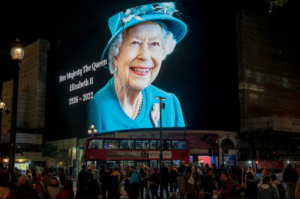Queen Elizabeth, and the Power and Limitations of Inspiring Women
There is a certain story about women’s progress that goes something like this: For too long, women have been held back by the personal prejudices of misguided individuals, and by society’s failure to imagine their potential for dazzling achievement. But if one extraordinary woman could cut her way through, proving the doubters wrong, others would be able to follow in her footsteps. And if women can lead, equality will follow.
I have young daughters, and I can find that story all over their bookshelves, in volumes such as “Good Night Stories for Rebel Girls,” a compendium of anecdotes about impressive women throughout history, carefully edited to remove any obstacles they faced that might horrify a 6-year-old. (Which is to say: pretty much all of them.)
Elizabeth II was born into power; she did not have to beat out male contenders for her job. But simply because she was a queen, not a king, her reign was easy to map onto that narrative: a monarch whose presence in the halls of power quietly refuted any argument that such places ought to be the sole province of men.
“She hasn’t been a flashy feminist, or even, she would probably say, a feminist at all,” said Arianne Chernock, a historian at Boston University who studies the relationship between the British monarchy and the women’s rights movement. “But through her deeds, far more than words, I think she has provided this very quiet alternative for women since she became queen.”
But the queen was also an object lesson on the limits of such “quiet alternatives” as catalysts for more widespread equality. Changing minds is useful. But changing societies, history shows, requires more.
Changing minds, but not systems
“If as many earnestly pray, the accession of Elizabeth II can help to remove the last shreds of prejudice against women aspiring to the highest places, then a new era for women will indeed be at hand,” Margaret Thatcher, who was then a young candidate attempting to break into politics, wrote in a column shortly after Elizabeth became queen in February 1952. “That there is a place for women at the top of the tree has been proved beyond question.”
“To sum up,” Thatcher concluded, “I should like to see the woman with a career holding down her responsibility with easy assurance during the Elizabethan era.” (The italics are hers.)
Thatcher, by the time she became Prime Minister in 1979, had become known for a flinty disdain of what she referred to as “women’s lib.” But she was not the only one to see the queen as a symbol for women’s empowerment, Chernock said.
“I think we forget now just how radical the queen was seen as,” she said. “Simply because, against that postwar backdrop, this was a woman who everyone was talking about following. Who commanded.”
In her research, she discovered American coverage of “queen-crazy” women who were inspired by Elizabeth. A psychologist interviewed in a 1953 article in the Los Angeles Times said that her ascension to the throne had given American women a “heroine who makes them feel superior to men,” and that wives would now want to have the same kind of authority in their own marriages that Elizabeth had with Prince Philip.
Digging further into history, Chernock found a similar reaction to Queen Victoria’s reign. “When Queen Victoria became queen in 1837, it really helped to precipitate a conversation about women’s suffrage,” she said. “That’s what I find fascinating about Elizabeth II and all the women who went before her, because simply having them at the apex of government opens up the space for other people to think about these radically different possibilities.”
But changing minds is not the same as changing realities.
Queen Victoria may have inspired the suffrage movement, but British women did not win the vote until long after her death, after a fierce campaign that saw many suffrage activists imprisoned, beaten, force-fed and deprived of custody of their children. (That did not stop Britain from citing its supposedly enlightened attitudes toward women as a justification for oppressive imperial rule in India and elsewhere.)
Queen Victoria was revered and beloved in her time, but her object lesson in queenship was not even enough to open a path for her own daughter to follow in her footsteps. Victoria privately believed that her eldest daughter would make a better ruler than her eldest son, Chernock said, but she never attempted to challenge male primogeniture publicly.
Queen Elizabeth’s reign saw a similar contrast between symbolism and effect. Although women around the world saw Elizabeth as a sign that women could reach the heights of power, in practice she stuck quite rigidly to traditional gender roles in terms of her behavior, clothes and public presentation of herself as a wife and mother.
She never publicly embraced feminism, and her support for women’s equality consisted largely of anodyne actions like praising successful female athletes, including women in her annual honors lists, and giving the occasional speech lauding women’s potential.
